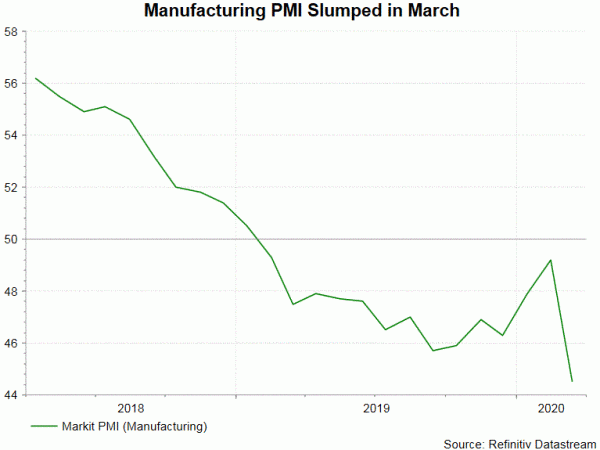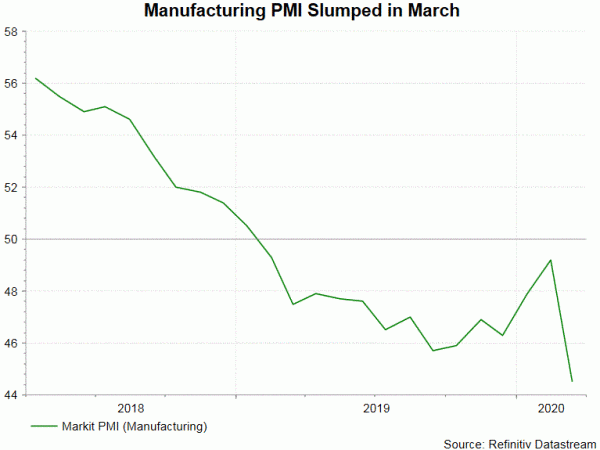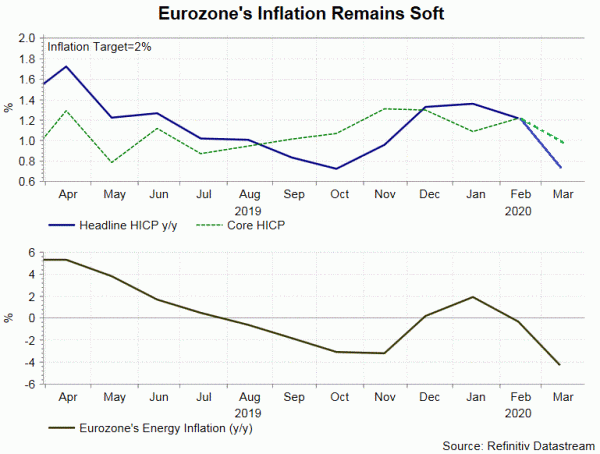Latest indicators for virus-haunted Eurozone’s economic developments suggest that the region is very close to recession. While accelerating QE, ECB refrained from lowering the policy rate March. We expect it would be obliged to do so in April. Meanwhile, coordinated fiscal action by the European Commission might be needed as the largest economies in the bloc are having a big hit.
Markit’s manufacturing PMI fell to 44.5 in March from 49.2 in February. The final reading was revised lower from the flash reading of 44.8. All country PMIs weakened from the prior month. Activities in the three major Eurozone economies, Germany, France, Italy, slumped. In Germany, manufacturing PMI plunged to 45.5, lowest in 11 years, from February’s 45.4. In France, the index fell to 43.2, down from 49.8 in February. This is the worst reading since 2013. Italy’s manufacturing PMI plummeted to 40.3 from February 48.7 in February. A reading below 50 signals contraction. The sharp fall in PMI readings in March were driven by factory shutdowns due to coronavirus and the lockdown of major cities. Both the supply and demand sides are severely affected. On the one hand, supplier delivery times have increased markedly as factories were closed and workers were unable to work due to movement restriction. On the other hand, movement ban and social distancing have reduced demand, while concerns over economic recession have stifled consumption.
Note that actual manufacturing activities could be worse than what have been revealed in the headline readings. The increase in input lead times, usually a sign of demand pressures, have contained the decline in the headline PMIs. However, the increase in lead times in March was driven by supply disruption, rather than stronger demand. Note also that Italy’s lockdown began on March 9, following by France and Germany in mid-March, the March report only reflected partial or initial impacts of such quarantine measure.
Headline HICP eased sharply to +0.7% y/y in March, from +1.2% a month ago. The market had anticipated a decline to +0.8%. Energy price was the key reason for the slowdown. Energy inflation contracted -4.3% q/q in March, deepening into the deflationary territory. Core inflation eased by -0.1 percentage point to +1.2%. Both headline and core readings suggest that Eurozone’s inflation remains far below ECB’s target of “below, but close to, 2%”. Again, the weakness has only reflected partial impact of the lockdown.
At the March meeting, ECB left the deposit rate unchanged at -0.5% but introduced an envelope to buy up to 120B euro until the end of the year. Moreover, the central bank launched new LTROs until June 2020 to fund banks’ liquidity needs. It also improved TLTRO-III by relaxing loan eligibility and increasing incentive rate, effective June 2020. Meanwhile, ECB announced a 750B euro Pandemic Emergency Purchase Programme (PEPP), in order to counter the serious risks to the monetary policy transmission mechanism and the outlook for the euro area posed by the outbreak and escalating diffusion of the coronavirus.
On the fiscal front, the European Commission has not announced any coordinated action, while individual member states have adopted fiscal stimulus. The European Commission has, however, temporarily allowed member states to run budget deficits above 3%. We expect to see more stimulus from both monetary and fiscal fronts.




 Signal2forex.com - មនុស្សយន្ត Forex ដែលល្អបំផុតនិងសញ្ញា
Signal2forex.com - មនុស្សយន្ត Forex ដែលល្អបំផុតនិងសញ្ញា




